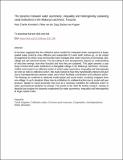The dynamics between water asymmetry, inequality and heterogeneity sustaining canal institutions in the Makanya catchment, Tanzania

View/
Date
2012-10-01Author
Komakech, Hans
van der Zaag, Pieter
van Koppen, Barbara
Metadata
Show full item recordAbstract
It has been suggested that the collective action needed for integrated water management at larger spatial scales could be more effective and sustainable if it were built, bottom-up, on the nested arrangements by which local communities have managed their water resources at homestead, plot, village and sub-catchment levels. The up-scaling of such arrangements requires an understanding of why they emerge, how they function and how they are sustained. This paper presents a case study of local level water institutions in Bangalala village in the Makanya catchment, Tanzania. Unlike most research on collective action in which water asymmetry, inequality and heterogeneity are seen as risks to collective action, this study looked at how they dynamically interact and give rise to interdependencies between water users which facilitate coordination and collective action. The findings are confined to relatively small spatial and social scales, involving irrigators from one village. In such situations there may be inhibitions to unilateral action due to social and peer pressure. Spatial or social proximity may thus be a necessary condition for collective action in water asymmetrical situations to emerge. This points to the need for further research, namely to describe and analyse the dynamics engendered by water asymmetry, inequality and heterogeneity at larger spatial scales.
